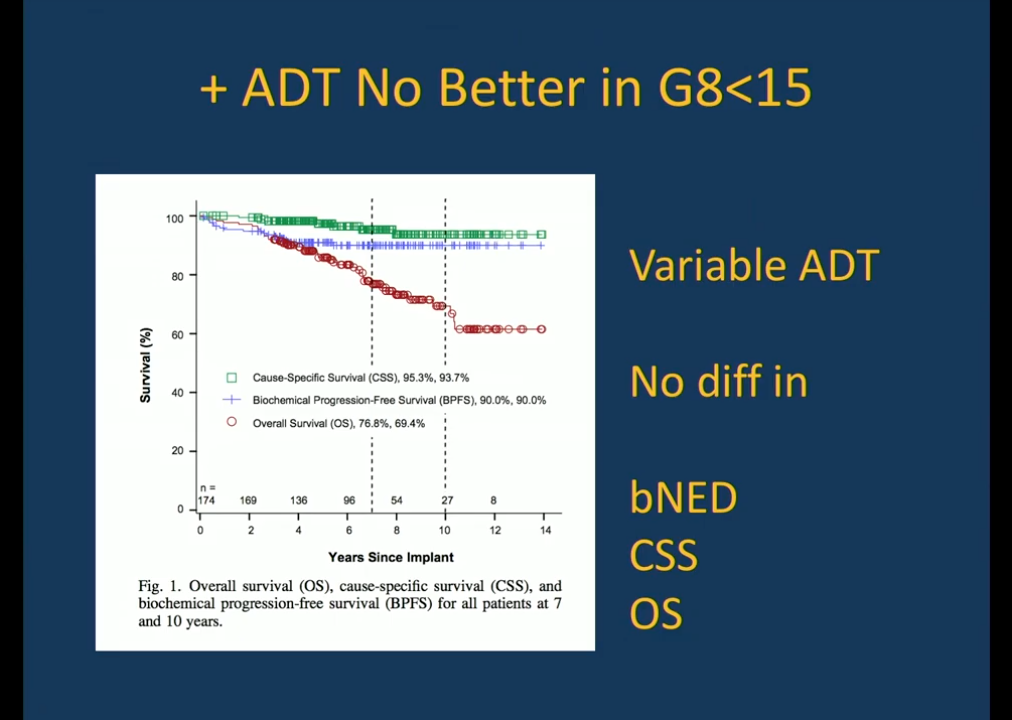Patrick W. McLaughlin, MD, presented “Hormone Therapy in High Risk Prostate Cancer” during the 24th Annual Southwest Prostate Cancer Symposium on April 12, 2019 in Scottsdale, Arizona.
How to cite: McLaughlin, Patrick W. “Hormone Therapy in High Risk Prostate Cancer” April 14, 2019. Accessed Jul 2025. https://grandroundsinurology.com/hormone-therapy-in-high-risk-prostate-cancer/
Hormone Therapy in High Risk Prostate Cancer – Summary:
Patrick W. McLaughlin, MD, discusses balancing the therapeutic effects of androgen deprivation therapy (ADT) with the impact of quality of life (QOL). He examines the best timing and radiotherapy regimen combination to pair with ADT, as well as properly assessing individual patients’ risk factors and disease severity when choosing treatment options.
Abstract:
If it is accepted that the modern definition of success in prostate cancer treatment is cure coupled with the patient’s QOL, physicians should minimize the use of ADT in high-risk cases. Treating patients with long-term ADT (LTADT) results in the increased risk of cardiovascular events (CE), suicide, and depression. Personality changes, increased loss of libido, and sexual dysfunction are also side effects of concern in LTADT use.
It is essential for LTADT to accompany external beam radiation therapy (EBRT) due to the overall survival benefit and local tumor response associated with this combination. However, when factoring in the full cure with QOL standard, combined-modality radiotherapy (CMRT) with short-term ADT (STADT) could be a more suitable option.
Unfortunately, there are not many studies investigating CMRT versus CMRT plus ADT. CMRT may cause significant toxicity, but this usually applies when brachytherapy doses are not correctly placed. When physicians implement a vessel-sparing radiotherapy and functional-anatomy based preservation method, patients who receive CMRT plus STADT see similar toxicity rates as patients who received EBRT and no ADT.
Also, evaluating locally advanced prostate cancer with MRI helps assess the severity of disease and determine the best treatment options.
Overall, combination therapy like CMRT does necessarily have unbearable toxicity, but correct dosing is important to prevent high toxicity. While ADT may have a limited role with CMRT, ADT combination with EBRT is generally considered beneficial. Additionally, if the full QOL impact of therapy is measured, CMRT with short-term ADT or no ADT is also considered better than EBRT with long-term ADT.
About the Southwest Prostate Cancer Symposium
The Southwest Prostate Cancer Symposium (SPCS) is a multi-day conference that seeks to educate urologists, radiation oncologists, medical oncologists, and other healthcare professionals involved in the treatment of prostate cancer. The topics focus on current technical aspects of diagnosis and treatment of localized and advanced disease, particularly regarding imaging, technology, and training in the related devices. Dr. McLaughlin presented this lecture during the 24th SPCS in 2019. In 2020, the 25th SPCS will also offer training sessions involving imaging, scanning, and prostate cancer treatment related devices on site. Please visit this page in order to register for future SPCS meetings.
ABOUT THE AUTHOR
Bill McLaughlin, MD, is a Professor of Radiation Oncology at University of Michigan Medicine. He is the Medical Director of Community Practices at Providence Hospital in Southfield, Michigan, and the Assarian Cancer Center in Novi, Michigan. Dr. McLaughlin is a board-certified radiation oncologist with a special interest in prostate cancer. Dr. McLaughlin is a member of the American Society for Therapeutic Radiology and Oncology (ASTRO) and the American Brachytherapy Society (ABS). Dr. McLaughlin pioneered MRI-based treatment planning for prostate implants and external beam therapy. Incorporating MRI imaging led to the development of vessel-sparing radiation analogous to nerve-sparing prostatectomy. MRI-based evaluation post implant has improved the accuracy of implant checking and improved the quality of prostate implants. These techniques have vastly improved the quality of life for men with prostate cancer. The results of this research were published in the International Journal of Radiation Oncology, Biology, and Physics. Dr. McLaughlin participated in the design of the Assarian Cancer Center, which features an integrated healing arts center and a program to improve patient and family support at all stages of the cancer experience.

